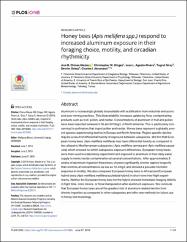| dc.contributor.author | Chicas-Mosier, Ana M. | |
| dc.contributor.author | Dinges, Christopher W. | |
| dc.contributor.author | Agosto-Rivera, Jose L. | |
| dc.contributor.author | Giray, Tuğrul | |
| dc.contributor.author | Oskay, Devrim | |
| dc.contributor.author | Abramson, Charles I. | |
| dc.date.accessioned | 2022-05-11T14:45:29Z | |
| dc.date.available | 2022-05-11T14:45:29Z | |
| dc.date.issued | 2019 | |
| dc.identifier.issn | 1932-6203 | |
| dc.identifier.uri | https://doi.org/10.1371/journal.pone.0218365 | |
| dc.identifier.uri | https://hdl.handle.net/20.500.11776/10057 | |
| dc.description.abstract | Aluminum is increasingly globally bioavailable with acidification from industrial emissions and poor mining practices. This bioavailability increases uptake by flora, contaminating products such as fruit, pollen, and nectar. Concentrations of aluminum in fruit and pollen have been reported between 0.05 and 670mg/L in North America. This is particularly concerning for pollinators that ingest pollen and nectar. Honey bees represent a globally present species experiencing decline in Europe and North America. Region specific decline may be a result of differential toxicity of exposure between subspecies. We find that European honey bees (Apis mellifera mellifera) may have differential toxicity as compared to two allopatric Mediterranean subspecies (Apis mellifera carnica and Apis mellifera caucasica) which showed no within subspecies exposure differences. European honey bees were then used in a laboratory experiment and exposed to aluminum in their daily water supply to mimic nectar contamination at several concentrations. After approximately 3 weeks of aluminum ingestion these bees showed significantly shorter captive longevity than controls at concentrations as low as 10.4mg/L and showed a possible hormetic response in motility. We also compared European honey bees to Africanized/European hybrid bees (Apis mellifera mellifera/scutellata hybrid) in short-term free-flight experiments. Neither the European honey bee nor the hybrid showed immediate foraging deficits in flight time, color choice, or floral manipulation after aluminum exposure. We conclude that European honey bees are at the greatest risk of aluminum related decline from chronic ingestion as compared to other subspecies and offer new methods for future use in honey bee toxicology. | en_US |
| dc.description.sponsorship | National Science FoundationNational Science Foundation (NSF) [1144467, 2016-1560389, 2015-1545803, HRD-1612560, HRD1736019] | en_US |
| dc.description.sponsorship | This research was funded in part by National Science Foundation Programs including the Graduate Research Fellowship Program (#1144467, awarded to AMCM: https://www.nsfgrfp.org/), Research Experiences for Undergraduates (#2016-1560389, awarded to JLAR, TG, and CIA: https://www.nsf.gov/crssprgm/reu/), Partnership for International Research and Education (#2015-1545803, awarded to JLAR, TG, and CIA: https://www.nsf.gov/pire), Louis Stokes Alliance for Minority Participation Bridge to the Doctorate (#HRD-1612560, awarded to AMCM: https://www.nsf.gov/funding/pgm_ summ. jsp? pims_ id= 13646) and Centers of Research Excellence in Science and Technology: Puerto Rico Center for Environmental Neuroscience (#HRD1736019, awarded to TG: https://www.nsf.gov/awardsearch/showAward? AWD_ ID= 1736019). The funders had no role in study design, data collection and analysis, decision to publish, or preparation of the manuscript. | en_US |
| dc.language.iso | eng | en_US |
| dc.publisher | Public Library Science | en_US |
| dc.identifier.doi | 10.1371/journal.pone.0218365 | |
| dc.rights | info:eu-repo/semantics/openAccess | en_US |
| dc.subject | Colony | en_US |
| dc.subject | Acetylcholinesterase | en_US |
| dc.subject | Accumulation | en_US |
| dc.subject | Diversity | en_US |
| dc.subject | Survival | en_US |
| dc.subject | Behavior | en_US |
| dc.subject | Selenium | en_US |
| dc.subject | Impact | en_US |
| dc.subject | Neonicotinoids | en_US |
| dc.subject | Insecticides | en_US |
| dc.title | Honey bees (Apis mellifera spp.) respond to increased aluminum exposure in their foraging choice, motility, and circadian rhythmicity | en_US |
| dc.type | article | en_US |
| dc.relation.ispartof | Plos One | en_US |
| dc.department | Fakülteler, Ziraat Fakültesi, Tarımsal Biyoteknoloji Bölümü | en_US |
| dc.authorid | 0000-0001-8961-3089 | |
| dc.identifier.volume | 14 | en_US |
| dc.identifier.issue | 6 | en_US |
| dc.institutionauthor | Oskay, Devrim | |
| dc.relation.publicationcategory | Makale - Uluslararası Hakemli Dergi - Kurum Öğretim Elemanı | en_US |
| dc.authorscopusid | 56507396000 | |
| dc.authorscopusid | 55904468200 | |
| dc.authorscopusid | 35279286300 | |
| dc.authorscopusid | 6602901451 | |
| dc.authorscopusid | 17135658000 | |
| dc.authorscopusid | 7004543157 | |
| dc.authorwosid | Oskay, Devrim/ABA-6576-2020 | |
| dc.identifier.wos | WOS:000484911900019 | en_US |
| dc.identifier.scopus | 2-s2.0-85069002706 | en_US |
| dc.identifier.pmid | 31246964 | en_US |



















